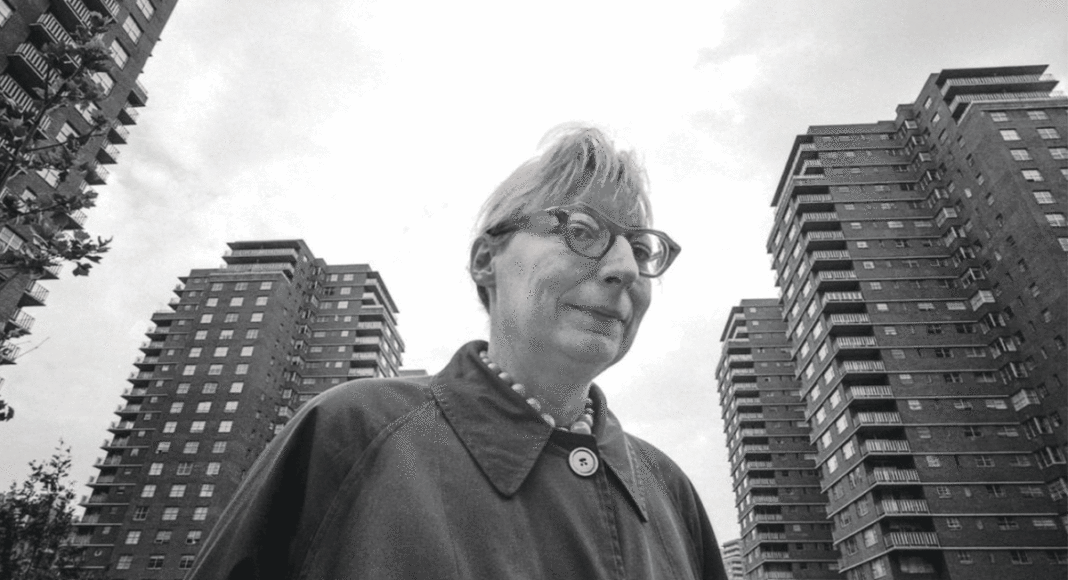Guess what? You can fight City Hall. With engagement, activism, and a keen sense of moral outrage, we, the people, can foil the best-laid plans of mice and politicians, however mighty they may think they are. Matt Tyrnauer’s excellent documentary, Citizen Jane: Battle for the City, shows how it’s done, a call to arms that could not be more timely in this chaotic political moment.
The city referred to in the movie’s subtitle is New York City. The story begins in the late 1950s, where the battle lines are drawn between Utopian post-war urban planning and the communities and concerns of real-life people. Leading the charge is Robert Moses, an imperious, celebrated urban planning czar who callously decrees, “You have to move a lot of people out of the way,” (mostly low-income residents) to make room for the so-called “Urban Renewal” he envisions. (Or, as James Baldwin calls it, in a vintage TV clip, “Negro Removal.”)
In the opposing corner is journalist Jane Jacobs, who develops her “theory of opposition” to Moses’ plans. A city resident since 1934, whose freelance stories on urban life earned her a position as Associate Editor at Architectural Forum magazine, Jacobs believes a city should be “a place with scope for all kinds of people.”
She believes that life lived out on the streets, on the stoops of old buildings and the sidewalks in front of them, creates community; even residents without a lot of money can create rich neighborhoods. Whereas Moses’ solution is to tear down all the old buildings, eliminate sidewalk culture, and remove people to soulless highrise towers: i.e.: housing projects. The welfare of the people involved, uprooted from their community life, is a matter of complete indifference to him. “You can’t make an omelet without breaking eggs,” he chuckles, in a TV clip.
Filmmaker Tyrnauer sets up Jacobs vs. Moses as a “battle for the soul of the city.” Jacobs has spent her career writing about street life and urban districts, figuring out how cities function. When cities really work, it’s from the bottom up, she believes, while Moses and his cronies at City Hall view the situation, literally, from the top down. It’s infuriating to see vintage footage of these complacent old white guys in their isolated skyscraper towers making life-disrupting decisions without any idea of how real people actually use space and interact down on the ground.
The results of this ignorance can be catastrophic. Without a lot of activity out in neighborhood sidewalks, “eyes on the street,” as Jacobs calls it, with people stacked up vertically in isolation from each other, crime festers. Drugs and vandalism increase because, without street culture, people are driven to desperation and frustration. When Moses “rammed through” the disastrous 20-year Cross-Bronx Expressway, not only were entire neighborhoods bulldozed, but the borough was cut in half, middle-class whites in flight on one side, while low-income people were shunted into derelict highrises run by slumlords on the other. Images of the area today look like scenes of nuclear devastation.
When Moses proposes The Lower Manhattan Expressway, which would have (among other things) destroyed the fabled SoHo neighborhood and imperiled Washington Square, Jacobs takes action. “As an individual, you can’t do anything,” she tells an interviewer. “But you can organize.” Which she does; building a coalition of opposition from sign-wielding mothers with baby carriages to Eleanor Roosevelt, they defeat Moses’ draconian vision of “progress.”
Tyrnauer posits that Jacobs’ influential book, The Death and Life of Great American Cities, published in 1961, is as defining a moment in 20th Century radical politics as Betty Friedan’s The Feminine Mystique (1962), and Rachel Carson’s Silent Spring (1963). Jacobs consistently fought for the lives and concerns of real people over insular, elitist planning goals and corporate greed. (Why destroy neighborhoods so ruthlessly? a TV interviewer asks her. Because “somebody is making money” on it, she replies.) It’s a fight we’re still engaged in right now.
CITIZEN JANE: BATTLE FOR THE CITY
**** (out of four)
With Jane Jacobs and Robert Moses. A documentary by Matt Tyrnauer. A Sundance Selects release. Not rated. 92 minutes.













